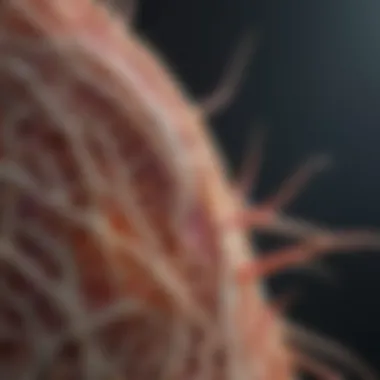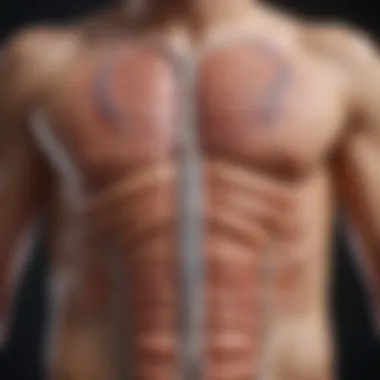A Comprehensive Examination of Nerve Endings


Intro
The human body exhibits an intricate network of nerve endings that play indispensable roles in how we perceive the world, respond to stimuli, and maintain homeostasis. Understanding the diverse structures and functions of these nerve endings is crucial for both basic science and clinical applications. The complexity of nerve endings can be observed in their varied types, such as free nerve endings, Meissner's corpuscles, and Pacinian corpuscles, each serving specific purposes in sensory processing.
In this article, we will explore the structural variations of nerve endings. Furthermore, we will examine their distribution throughout the body, dissect their roles in sensory perception and motor control, and assess how nerve damage can lead to significant functional impairments. The implications of ongoing research into nerve regeneration and therapeutic strategies will also be scrutinized alongside the current advancements in neurobiology.
This exploration intends to cater to students, researchers, educators, and professionals who seek a deeper understanding of neurophysiology as it relates to both foundational concepts and cutting-edge findings.
Research Highlights
Overview of Key Findings
Nerve endings are not uniform. They come in various types, and each type is adapted to its specific function. For instance, free nerve endings primarily respond to pain and temperature, whereas specialized nerve endings, like those found in the skin, respond to pressure and vibration. Other highlights include:
- Structural adaptations that enhance sensitivity to specific stimuli.
- The distribution of nerve endings varies across different tissues and organs, impacting sensation and motor response.
- Damage to nerve fibers can lead to chronic pain or functional loss, highlighting the importance of effective regeneration strategies in neuroscience.
Significance of the Research
Understanding the diverse structures of nerve endings is vital for several reasons. It informs medical professionals about potential interventions for nerve damage, pain management, and rehabilitation strategies. Moreover, insights gained from the study of nerve endings can contribute to the development of neuroprosthetics and other biotechnological advancements that aim to restore sensory or motor function.
"The capability of nerve endings to regenerate could unlock new pathways for treating degenerative diseases and injuries that affect the nervous system."
Original Research Articles
Summary of the Article
The articles reviewed encompass recent findings in neurobiology, focusing on the structural variations, functional roles, and regeneration of nerve endings. These studies provide an essential framework for understanding both the basic science of sensory neuron functiion and the clinical implications of nerve injury.
Author Contributions
Contributions from various researchers highlight interdisciplinary efforts in this field, bringing together insights from molecular biology, pharmacology, and rehabilitation science. These collaborative efforts aim to foster innovative solutions for unresolved issues related to nerve damage and function.
Through this comprehensive examination, we aim to provide a detailed narrative that expands on the role of nerve endings in both healthy and pathological states, illustrating the ongoing importance of this research in modern science.
Prelude to Nerve Endings
Nerve endings play a crucial role in our body's communication system. They are essential for transmitting sensations and coordinating responses. An understanding of nerve endings helps illuminate their functions in sensory perception and motor control. In this article, we will delve into their structures and functions, contributing to a more comprehensive knowledge of neurophysiology.
Definition and Importance
Nerve endings, also known as nerve terminals, are the endpoints of neurons that facilitate communication within the nervous system. These structures can be classified into various types, each with distinct roles. For instance, free nerve endings are vital in sensing pain and temperature, while specialized nerve endings, like those found in tactile corpuscles, are essential for touch sensation. The importance of nerve endings lies not only in their function but also in their ability to affect overall health. Understanding these connections provides insights into how sensory information is processed in the brain.
By studying nerve endings, researchers can develop strategies to treat sensory disorders and injuries. Thus, knowledge about nerve endings is crucial for educating healthcare professionals and researchers in neurobiology.
Historical Perspectives
The study of nerve endings has evolved significantly. Early research on the nervous system often relied on gross anatomical observations. Scientists like Santiago Ramón y Cajal advanced our understanding by using staining techniques to visualize individual neurons. His work laid the foundation for modern neuroanatomy, showcasing the diversity of nerve endings and their connections.
In the mid-20th century, advancements in electrophysiology allowed scientists to study nerve endings in a dynamic context. Methods such as patch-clamp techniques enabled recordings of electrical signals from neurons, further elucidating how nerve endings function. Today, cutting-edge technology continues to expand our understanding of nerve endings, paving the way for future discoveries in the field.
Through meticulous study, it has become clear that nerve endings are not merely connectors; they are integral to how organisms interact with their environment. This historical insight assists contemporary researchers in tracing the development of neurophisiological concepts, ultimately enhancing our understanding of nerve endings.
Anatomy of Nerve Endings
The anatomy of nerve endings is crucial for understanding how the nervous system functions at a fundamental level. Nerve endings serve as the primary interface between the body and the external environment, enabling the transmission of sensory information. These structures are diverse in their morphology and function, which reflects the complex requirements of sensory processing and response. By exploring their anatomy, we gain insight into how these specialized structures contribute to various physiological processes, including sensation, reflexes, and motor function.
Structure and Components
Nerve endings consist of distinct structural elements that contribute to their function. At a basic level, each nerve ending contains a sensory neuron and its associated components. The sensory neuron typically comprises a cell body, dendrites, and an axon. The axon extends to the target area where it communicates with other neurons or cells. The structure of nerve endings varies based on the type of sensory information they process.


- Dendrites are branching extensions that receive stimuli from the environment. They are integral to the quality and accuracy of sensory perception.
- Myelin Sheath surrounds the axon in some nerve endings, which aids in the rapid transmission of nerve impulses.
- Axon Terminals house neurotransmitters, essential for communication between nerve endings and other cells.
These elements work together harmoniously, enabling the effective processing of sensory modalities.
Types of Nerve Endings
Understanding the types of nerve endings elaborates on their specialized functions within the body. Nerve endings are classified into three main categories based on their structure and function:
Free Nerve Endings
Free nerve endings are the simplest form of nerve endings. They are characterized by their lack of specialized structures and are widely distributed throughout the body. Their primary role is in the perception of pain and temperature. The key characteristic of free nerve endings is that they are not encapsulated, allowing them to respond to a broad range of stimuli. This makes them an essential choice for exploring pain mechanisms in clinical settings.
The unique feature of free nerve endings lies in their ability to respond to different environmental changes. They have advantages in terms of their sensitivity to stimuli but may also lead to non-specific responses, such as chronic pain under certain conditions.
Encapsulated Nerve Endings
Encapsulated nerve endings, as the name suggests, are structured with a capsule that envelops the nerve ending. These structures include Pacinian corpuscles and Meissner's corpuscles, which play significant roles in the sensation of pressure and touch. The key characteristic of encapsulated nerve endings is their ability to amplify and finely tune sensory signals. This makes them beneficial for understanding tactile discrimination.
A unique feature of these nerve endings is their complex structure, which enhances the detection of specific types of stimuli. Their advancement in sensitivity, however, may come with a drawback: they can be more susceptible to damage or dysfunction due to their complex design.
Specialized Nerve Endings
Specialized nerve endings are tailored for specific sensory modalities, such as vision, hearing, and taste. An example includes photoreceptors in the retina that are uniquely structured to detect light. The key characteristic of specialized nerve endings is their high degree of specificity. This is advantageous for contexts needing precise sensory input.
The unique feature of these specialized endings is the adaptation to their specific sensory functions, allowing for distinguished responses to unique stimuli. However, their specialization can also limit flexibility in processing varied sensory information.
"Nerve endings play an essential role in navigating and reacting to our environment, making their anatomical study vital for a comprehensive understanding of neurophysiology."
Functional Role of Nerve Endings
Understanding the functional role of nerve endings is essential to grasp the broader context of neurophysiology. Nerve endings serve as the crucial interface between sensory stimuli and the central nervous system. They play a key role in both sensory and motor functions, providing a gateway for the body to interact with its environment. This extends beyond mere detection, influencing how organisms respond and adapt.
Sensory Functions
Sensory functions are among the most critical roles of nerve endings. They contribute directly to the perception of various stimuli, allowing organisms to respond appropriately. The various sensory functions include:
- Pain Perception
Pain perception is vital to survival. It enables individuals to detect potential harm. This function depends on nociceptors, specialized nerve endings that respond to damaging stimuli. The ability to feel pain alerts us to injury or disease, prompting protective actions. Moreover, pain serves as a compelling motivator to change behavior, preventing further harm. One unique feature of pain perception is its subjective nature. The intensity of perceived pain can vary widely from person to person, influenced by emotional and cultural factors. While this variability can complicate treatment, understanding different pain types enhances therapeutic approaches. - Temperature Sensation
Temperature sensation plays a significant role in maintaining homeostasis. Thermoreceptors detect changes in temperature, prompting body adjustments. For instance, when temperatures drop, the body may shiver to generate heat. The specific characteristic of temperature sensation is its duality; it not only conveys warmth or coolness but also sharpens our response to extreme temperatures. This reaction can be beneficial, as it can prevent burns or frostbite. However, temperature sensation can be less precise, sometimes resulting in discomfort without the immediate danger of harm. - Touch and Pressure Touch and pressure receptors are fundamental to physical interactions with the world. Mechanoreceptors in the skin enable fine motor skills, balance, and navigation. The unique advantage of touch and pressure is the detail they provide about texture and shape, which is crucial for tasks ranging from writing to crafting. This information enriches our experiences but can also lead to sensory overload in instances where excessive stimulation occurs, complicating the perception of other signals.
Motor Functions
Motor functions facilitated by nerve endings integrate smoothly with sensory feedback, enabling coordinated actions. Motor responses are essential for survival and adaptation. They are often categorized as follows:
- Neuromuscular Junctions
Neuromuscular junctions are specialized synapses enabling communication between motor neurons and muscle fibers. Their primary function is to facilitate muscle contractions. A significant characteristic of neuromuscular junctions is their efficiency in transmitting signals. This efficiency is crucial for precise movements. For example, the rapid response when catching a falling object relies heavily on these junctions. However, issues in this area can lead to conditions like myasthenia gravis, which impair muscular function and response. - Reflex Actions
Reflex actions provide a fascinating illustration of the body's quick response system. These automatic responses enable organisms to react swiftly to potentially dangerous situations. The unique aspect of reflex actions lies in their involuntary nature. This characteristic allows for immediate responses without requiring conscious thought. However, while reflexes protect us from harm, they may lack the nuance of voluntary movements, potentially leading to unintended consequences in certain contexts.
Pain perception, temperature sensation, touch and pressure, neuromuscular junctions, and reflex actions all highlight the intricate relationship between nerve endings and physiological functions. Their effectiveness allows for survival, interaction, and adaptation.
Distribution of Nerve Endings in the Body
Understanding the distribution of nerve endings in the human body is crucial for comprehending their functions and implications in health and disease. Nerve endings connect the nervous system to various tissues, playing vital roles in sensory perception and motor function. Their varied locations contribute to the body’s ability to react and adapt to changes in the environment, making this topic significant in both neurobiology research and clinical practice.
Dermal Nerve Endings
Dermal nerve endings are primarily responsible for detecting touch, pressure, pain, and temperature. They are predominantly found in the skin, offering a complex network that interacts with the external world. These endings can be classified into different types:
- Free nerve endings: These are the most common type and are sensitive to pain and temperature. They are located just beneath the epidermis and are widely distributed throughout the skin.
- Meissner's corpuscles: These are highly sensitive to light touch and are concentrated in areas such as the fingertips and lips.
- Pacinian corpuscles: They respond to deep pressure and vibration, primarily located in the deeper layers of the dermis.
The function of dermal nerve endings extends beyond sensation. They also play a role in protective reflexes and help maintain homeostasis by signaling the body to respond to harmful stimuli. The rich distribution of these endings enhances our ability to perceive fine details in our environment.
Nerve Endings in Internal Organs


Nerve endings are not limited to the skin; they are also present in internal organs. These endings are crucial for visceral sensation and play a significant role in monitoring physiological states. For example, they can detect stretch in the bladder or monitor chemical changes in the gastrointestinal tract. Important aspects include:
- Baroreceptors: Located in blood vessels, these nerve endings monitor blood pressure and help regulate cardiovascular functions.
- Chemoreceptors: These endings are sensitive to changes in oxygen, carbon dioxide, and pH levels, playing a part in respiratory control.
The presence of nerve endings in internal organs enables the body to react to changes within itself. This aspect is vital for functions such as digestion, circulation, and waste elimination. Understanding these distributions informs us about organ function and dysfunction.
Nervous System and Nerve Ending Distribution
The nervous system has a strategic architecture regarding nerve ending distribution. It allows rapid communication between the central nervous system (CNS) and peripheral organs. Within the CNS, nerve endings help relay sensory information, while in the periphery, they facilitate motor output. Key points include:
- Spinal Cord and Brain: Central structures received signals from various body parts through distinct pathways, which correspond to different sensory modalities.
- Peripheral Nerves: These nerves travel to all parts of the body, ensuring that nerve endings are widely and efficiently distributed.
This intricate organization underscores the importance of nerve ending distribution in integrating sensory information and coordinating responses. Knowledge of this distribution is essential for understanding both normal functioning and the various disorders that can occur when these networks are compromised.
"The distribution of nerve endings across different tissues highlights the complexity of interactions between the nervous system and body, influencing responses to both internal and external stimuli."
Overall, the distribution of nerve endings throughout the body is a fundamental aspect that informs their sensory roles and functional contributions. It lays the groundwork for further exploration into how these structures impact health, recovery, and the potential for various medical interventions.
Nerve Damage and Repair Mechanisms
Understanding nerve damage and its repair processes is crucial in the study of nerve endings. Nerves can endure various injuries, impacting sensory and motor functions significantly. This section will delve into the causes of nerve damage, the mechanisms by which nerves may regenerate, and the role of specific cells in the repair process. Knowing these factors not only advances our comprehension of neurobiology but also shapes therapeutic strategies aimed at minimizing damage and enhancing recovery.
Causes of Nerve Damage
Nerve damage can occur due to several factors. Common causes include:
- Trauma: Physical injuries like cuts, fractures, or nerve compression can sever or disrupt nerve continuity.
- Diseases: Conditions such as diabetes mellitus can result in diabetic neuropathy, which affects nerve function over time.
- Toxins: Exposure to certain chemicals, medications, or heavy metals can lead to nerve injury.
- Infections: Viruses or bacteria can infiltrate and damage nerve tissues, often leading to inflammation.
- Genetic disorders: Some inherited conditions, such as Charcot-Marie-Tooth disease, can compromise nerve integrity.
These diverse causes of nerve damage signify the intricate relationship between environmental factors, biological processes, and nerve health. Recognizing these causes helps in crafting suitable treatment plans and preventive measures.
Regeneration of Nerve Endings
After nerve injury, regeneration is essential for restoring functions. It involves several stages, primarily focusing on axonal regeneration and the role of Schwann cells.
Axonal Regeneration
Axonal regeneration is the process whereby injured axons attempt to reconnect. A central aspect of this process is the ability of axons to regrow towards target tissues. One key characteristic of axonal regeneration is that it usually occurs in peripheral nerves, which have a greater capacity for repair than central nervous system nerves.
- Benefits of Axonal Regeneration: This capacity for regeneration is particularly beneficial in peripheral nervous system injuries, allowing for functional recovery and the restoration of sensations.
- Unique Features: A unique feature of axonal regeneration is that it often occurs via a growth cone, guiding axonal sprouts towards their targets. However, it can also lead to abnormal connections, known as neuroma formation, which may result in chronic pain.
The ability of axons to regenerate illustrates the dynamic nature of nerve endings and the potential for recovery after injury.
Role of Schwann Cells
Schwann cells are a type of glial cell in the peripheral nervous system crucial for nerve repair. They play an essential role in supporting axonal regrowth. Schwann cells create a supportive environment by releasing growth factors that promote regeneration.
- Key Characteristic: The capacity of Schwann cells to dedifferentiate, proliferate, and form a regeneration tube is a vital characteristic. This supports the regrowth of axons through conducive pathways.
- Advantages: Schwann cells aid in the cleanup of debris left by damaged nerves, further enhancing the recovery process.
- Disadvantages: On the other hand, they can also play a part in forming scar tissue that may hinder overall nerve function if not regulated during the healing process.
In summary, understanding nerve damage and repair mechanisms is pivotal for insights into nerve endings. The identification of causes and subsequent regeneration processes reveals the complexity of nerve healing, contributing to the wider field of neurophysiology.
Clinical Implications of Nerve Ending Research
Understanding the clinical implications of nerve ending research is critical. This field explores how nerve endings contribute to various health conditions. With advancements in our knowledge, this area reveals important insights into diagnosis and treatment strategies.
Neuropathies and Disorders
Neuropathies are disorders affecting the peripheral nervous system. Common examples include diabetic neuropathy and carpal tunnel syndrome. These conditions arise when nerve endings are damaged or dysfunctional. Symptoms may include pain, numbness, and impaired sensory functions. Research helps identify the underlying mechanisms of these disorders, allowing for better management and intervention strategies.
One crucial aspect is understanding how nerve damage impacts not only sensation but also motor function. For instance, in diabetic neuropathy, the damage can lead to balance issues. Continuous research helps find new ways to treat and manage these conditions effectively.


Therapeutic Approaches
Pharmacological Interventions
Pharmacological interventions play a significant role in managing neuropathies and related disorders. These interventions usually involve medications prescribed to alleviate symptoms. Common types include analgesics, anticonvulsants, and antidepressants. Each offers different benefits and targets various symptoms.
The key characteristic of pharmacological interventions is their ability to modify pain perception. This is crucial in conditions where chronic pain is a major symptom. For many patients, these medications provide relief and improve quality of life. However, it's important to consider potential side effects, which may vary from mild to severe, depending on the medication.
Research shows that effective pain management can enhance the overall outcomes for patients, allowing them to engage more fully in therapy and day-to-day activities.
A unique feature of these interventions is that they can be tailored to individual needs. This personalization helps address the diverse presentations of nerve-related disorders. Nevertheless, long-term use of certain medications may lead to dependency or reduced effectiveness over time.
Physical Rehabilitation
Physical rehabilitation is another crucial therapeutic approach for managing nerve-related conditions. This form of therapy focuses on restoring function and improving mobility. Rehabilitation often includes exercises designed to strengthen muscles and enhance coordination.
The key characteristic of physical rehabilitation is its holistic approach. Instead of merely addressing symptoms, it aims to restore overall function and promote recovery. For many patients, engaging in physical activity improves both physical and mental health, leading to better health outcomes.
A unique feature of this approach is its non-invasive nature. Unlike pharmacological treatments, physical rehabilitation typically avoids the complications associated with medication. However, it requires commitment and consistency from patients to achieve optimal results.
Current Research Trends
Research on nerve endings is evolving rapidly, showing promise for better understanding and treatment of various neurological conditions. This section highlights the current trends that shape our knowledge of these critical structures. Innovations in neurobiology and interdisciplinary approaches are at the forefront, each contributing significantly to the advancement of healthcare and therapeutic methods.
Innovations in Neurobiology
Innovations in neurobiology focus on developing new techniques and methods for studying nerve endings. Researchers utilize advanced imaging techniques that allow for real-time observation of nerve functions. These innovations have opened doors to understanding how nerve endings communicate and respond in various conditions. The insights gained from such studies lead to improved diagnostic methods and more effective treatments.
Moreover, innovations in neurobiology often involve genetic studies that can provide a deeper understanding of nerve cell function at a molecular level. Discovering gene expressions related to nerve damage repair has particular relevance in developing tailored therapies for neuropathic pain and other disorders.
Future Directions
The future of nerve ending research seems promising, with several exciting directions emerging. Among these, technological advances and interdisciplinary approaches are shaping new pathways for scientific exploration.
Technological Advances
Technological advances play a crucial role in expanding our understanding of nerve endings. For instance, optogenetics has become a favorite research tool. This technique allows scientists to manipulate neuronal activity with specific light wavelengths. The ability to activate or inhibit nerve endings precisely enhances research on sensory and motor functions.
Another essential technological aspect includes the development of functional MRI and machine learning algorithms. These tools help analyze large data sets related to nerve activity and dysfunction, yielding valuable insights into conditions like chronic pain or movement disorders. While the cost of implementing these technologies can be high, their benefits in transforming nerve research into an evidence-based science are significant.
Interdisciplinary Approaches
Interdisciplinary approaches integrate knowledge from various fields to address complex questions regarding nerve endings. By collaborating with fields like robotics, biochemistry, and computational neuroscience, researchers can develop novel therapeutic strategies. For example, robotic technologies can assist in rehabilitation efforts for patients recovering from nerve damage.
The key characteristic of these approaches is their ability to merge various expertise and resources, enabling holistic insights into nerve functionality. While challenges exist related to the integration of different scientific languages and methodologies, the potential for innovative solutions makes interdisciplinary collaboration a compelling choice in research.
Interdisciplinary approaches can lead to breakthroughs that single-discipline research might overlook, particularly in complex fields like neurobiology.
Ending
The final section of an article provides an opportunity to consolidate information and stress the significance of the topic discussed. In the context of nerve endings, the conclusion serves to reinforce the complex roles these structures play in human physiology. Understanding nerve endings is crucial, as they contribute to sensory perception, motor functions, and the overall responsiveness of the nervous system.
Summary of Key Points
This article has explored various dimensions of nerve endings, emphasizing their:
- Definition: Nerve endings are the terminal points of neurons that facilitate communication within the nervous system.
- Types: Different classifications include free nerve endings, encapsulated nerve endings, and specialized ones, each tailored to specific sensory modalities.
- Distribution: Nerve endings are widespread throughout the body, with unique concentrations in the dermis, internal organs, and the central nervous system.
- Functional Role: They are integral to sensory functions such as pain perception and touch, as well as motor functions that involve reflex actions.
- Regeneration: The mechanisms underpinning nerve repair involve complex biological processes that are vital for recovery following injury.
- Clinical Implications: Ongoing research into nerve endings informs the understanding of various neuropathies and refines therapeutic strategies.
These points highlight the multifaceted nature of nerve endings, illustrating their importance in both health and disease.
Implications for Future Research
Research into nerve endings continues to evolve, opening up new avenues for exploration. Future studies might focus on:
- Technological Advances: Innovations in imaging and electrophysiology can enhance our understanding of nerve function and dysfunction.
- Interdisciplinary Approaches: Collaboration between neurobiology, engineering, and rehabilitation science can lead to novel treatments for nerve-related impairments.
- Regeneration Mechanisms: Understanding the nuances of how nerve endings and associated cells like Schwann cells contribute to recovery could improve therapeutic outcomes.
The implications of these potential research avenues underscore the need for continued inquiry into the role of nerve endings in bodily functions and disorders.







